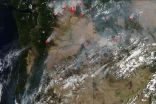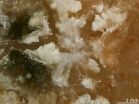Scientists discover mechanism behind 'strange' earthquakes
Currents of semi-liquid rock key to seismicity away from tectonic plate boundaries
2015-08-26
(Press-News.org) It's not a huge mystery why Los Angeles experiences earthquakes. The city sits near a boundary between two tectonic plates -- they shift, we shake. But what about places that aren't along tectonic plate boundaries?
For example, seismicity on the North American plate occurs as far afield as southern Missouri, where earthquakes between 1811 and 1812 estimated at around magnitude 7 caused the Mississippi River to flow backward for hours.
Until now, the cause of that seismicity has remained unclear.
While earthquakes along tectonic plate boundaries are caused by motion between the plates, earthquakes away from fault lines are primarily driven by motion beneath the plates, according to a new study published by USC scientist Thorsten Becker in Nature on Aug. 27.
Just beneath the Earth's crust is a layer of hot, semi-liquid rock that is continually flowing -- heating up and rising, then cooling and sinking. That convective process, interacting with the ever-changing motion of the plates at the surface, is driving intraplate seismicity and determining in large part where those earthquakes occur. To a lesser extent, the structure of the crust above also influences the location, according to their models.
"This will not be the last word on the origin of strange earthquakes. However, our work shows how imaging advances in seismology can be combined with mantle flow modeling to probe the links between seismicity and mantle convection," said Becker, lead author of the study and professor of Earth sciences at the USC Dornsife College of Letters, Arts and Sciences.
Becker and his team used an updated mantle flow model to study the motion beneath the mountain belt that cuts north to south through the interior of the Western United States.
The area is seismically active -- the reason Yellowstone has geysers is that it sits atop a volcanic hotspot. Previously, scientists had suggested that the varying density of the plates was the main cause. (Imagine a mountain's own weight causing it to want to flow apart and thin out.)
Instead, the team found that the small-scale convective currents beneath the plate correlated with seismic events above in a predictable way. They also tried using the varying plate density or "gravitational potential energy variations" to predict seismic events and found a much poorer correlation.
"This study shows a direct link between deep convection and shallow earthquakes that we didn't anticipate, and it charts a course for improved seismic hazard mapping in plate interiors," said Tony Lowry, co-author of the paper and associate professor of geophysics and geodynamics at Utah State University.
INFORMATION:
Becker and Lowry collaborated with researchers from University Roma Tre in Italy, the University of New Mexico, Scripps Institution of Oceanography and the Massachusetts Institute of Technology.
The full study can be found online at http://dx.doi.org/10.1038/nature14867. This research was supported by the National Science Foundation, grants EAR-0350028, EAR-0732947, EAR-1215720, EAR-1215757, EAR-0955909, and EAR-1358622; and by the Southern California Earthquake Center.
ELSE PRESS RELEASES FROM THIS DATE:
2015-08-26
The Pacific Northwest is abundantly dotted with wildfires in Washington, Oregon, Idaho and Montana. There are over 27 fires listed in the Inciweb database for the state of Washington. The largest active fire listed is the Okanogan Complex Fire which is currently at 256,567 acres and has 1,250 personnel working the fire. This fire began as a lightning strike on August 15, 2015. It is only 10% contained at present. Governor Inslee's request for a federal Emergency Declaration to provide additional resources to cover some of the costs related to multiple wildfires burning ...
2015-08-26
Mostly untouched for 100 years, 15 Roman-era Egyptian mummy portraits and panel paintings were literally dusted off by scientists and art conservators from Northwestern University and the Phoebe A. Hearst Museum of Anthropology as they set out to investigate the materials the painters used nearly 2,000 years ago.
What the researchers discovered surprised them, because it was hidden from the naked eye: the ancient artists used the pigment Egyptian blue as material for underdrawings and for modulating color -- a finding never before documented. Because blue has to be manufactured, ...
2015-08-26
UC San Francisco researchers have for the first time developed a method to precisely control embryonic stem cell differentiation with beams of light, enabling them to be transformed into neurons in response to a precise external cue.
The technique also revealed an internal timer within stem cells that lets them tune out extraneous biological noise but transform rapidly into mature cells when they detect a consistent, appropriate molecular signal, the authors report in a study published online August 26 in Cell Systems.
"We've discovered a basic mechanism the cell uses ...
2015-08-26
Companies can promote creativity in employees by encouraging them to network beyond their immediate business networks, according to a new study by management experts at Rice University, Australian National University (ANU), Erasmus University Rotterdam, Monash University in Clayton, Australia, and the University of Los Andes in Bogota, Colombia.
"Social networks can be important sources of information and insight that may spark employee creativity," the authors said. "The cross-fertilization of ideas depends not just on access to information and insights through one's ...
2015-08-26
CAMBRIDGE, Mass.--For more than a decade, gene sequencers have been improving more rapidly than the computers required to make sense of their outputs. Searching for DNA sequences in existing genomic databases can already take hours, and the problem is likely to get worse.
Recently, Bonnie Berger's group at MIT's Computer Science and Artificial Intelligence Laboratory (CSAIL) has been investigating techniques to make biological and chemical data easier to analyze by, in some sense, compressing it.
In the latest issue of the journal Cell Systems, Berger and colleagues ...
2015-08-26
Among our greatest achievements as humans, some might say, is our cumulative technological culture -- the tool-using acumen that is passed from one generation to the next. As the implements we use on a daily basis are modified and refined over time, they seem to evolve right along with us.
A similar observation might be made regarding the New Caledonian crow, an extremely smart corvid and the only non-human species hypothesized to possess its own cumulative technological culture. How the birds transmit knowledge to each other is the focus of a study by Corina Logan, a ...
2015-08-26
Two studies and an editorial published online by JAMA Psychiatry examine associations between cannabis use and the brain.
Cannabis, also known as marijuana, is a popular recreational drug and its legal status has been a source of enduring controversy.
In the first study, David Pagliaccio, Ph.D., formerly of Washington University in St. Louis, and now at the National Institute of Mental Health, Bethesda, Md., and coauthors analyzed data from a group of twin/siblings (n=483 with 262 participants reporting ever using cannabis in their lifetime) to determine whether cannabis ...
2015-08-26
Toronto, CANADA - Male teens who experiment with cannabis before age 16, and have a high genetic risk for schizophrenia, show a different brain development trajectory than low risk peers who use cannabis.
The discovery, made from a combined analysis of over 1,500 youth, contributes to a growing body of evidence implicating cannabis use in adolescence and schizophrenia later in life.
The study was led by Baycrest Health Sciences' Rotman Research Institute in Toronto and is reported in JAMA Psychiatry (online) today, ahead of print publication.
Adolescence is a period ...
2015-08-26
Putnam Valley, NY. (Aug. 26, 2015) - Liver transplantation is currently the only established treatment for patients with end stage liver failure. However, this treatment is limited by the shortage of donors and the conditional integrity and suitability of the available organs. Transplanting donor hepatocytes (liver cells) into the liver as an alternative to liver transplantation also has drawbacks as the rate of survival of primary hepatocytes is limited and often severe complications can result from the transplantation procedure.
In an effort to find potential therapeutic ...
2015-08-26
Washington, DC--New research from a team led by Carnegie's Robert Hazen predicts that Earth has more than 1,500 undiscovered minerals and that the exact mineral diversity of our planet is unique and could not be duplicated anywhere in the cosmos.
Minerals form from novel combinations of elements. These combinations can be facilitated by both geological activity, including volcanoes, plate tectonics, and water-rock interactions, and biological activity, such as chemical reactions with oxygen and organic material.
Nearly a decade ago, Hazen developed the idea that the ...
LAST 30 PRESS RELEASES:
[Press-News.org] Scientists discover mechanism behind 'strange' earthquakes
Currents of semi-liquid rock key to seismicity away from tectonic plate boundaries


